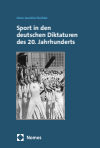Zusammenfassung
Basis der vorliegenden Publikation sind Teichlers Untersuchungen zum Sport in der NS-Zeit und zum Sport in der DDR. Während das NS-Regime qua Sport die Überlegenheit der arischen Rasse nachweisen wollte, versuchte die DDR-Diktatur die Überlegenheit des Sozialismus über den Kapitalismus zu demonstrieren. Im NS-Teil wird zuerst auf Akteure wie Riefenstahl, Schmeling und Diem eingegangen. Dann stehen die Olympischen Spiele von Berlin 1936 und das Verhältnis zum IOC im Mittelpunkt. Teil II (DDR) thematisiert die schwierigen Anfänge in den 1950er Jahren, das olympische Wettrüsten der 1960er und die Doping-Thematik der 1970er und 1980er Jahre. Eine Analyse von Eingaben zum Sport untersucht die Mangelsituationen im Alltag des Sportwunderlandes.
Abstract
The basis of this publication is Teichler's research on sport in the Nazi era and on sport in the GDR. While the Nazi regime sought to demonstrate the superiority of the Aryan race through sport, the GDR dictatorship sought to demonstrate the superiority of socialism over capitalism. The Nazi section first discusses figures such as Riefenstahl, Schmeling, and Diem. Then the focus is on the 1936 Berlin Olympics and the relationship with the IOC. Part II (GDR) addresses the difficult beginnings in the 1950s, the Olympic arms race of the 1960s, and the doping issue of the 1970s and 1980s. An analysis of submissions on sports examines the shortcomings of everyday life in the sports wonderland.
Schlagworte
20th century 20. Jahrhundert Aryan race Arische Rasse Berlin 1936 dictatorships doping DDR-Diktatur Diem GDR dictatorship Diktaturen history Nazi regime Doping Olympic arms race Geschichte IOC Olympic Games NS-Regime politics Olympische Spiele socialism sports Olympisches Wettrüsten Politik sports history Riefenstahl Schmeling Sozialismus Sport Sportgeschichte- 31–184 Akteure 31–184
- 359–646 SBZ und DDR 359–646
- 617–630 Ergebnis 617–630
- 631–646 Das Erbe des DDR Sports 631–646

